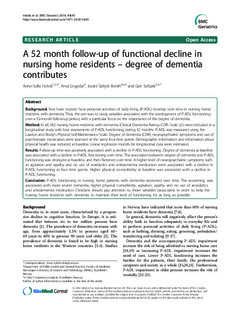| dc.contributor.author | Helvik, Anne-Sofie | |
| dc.contributor.author | Engedal, Knut | |
| dc.contributor.author | Saltyte Benth, Jurate | |
| dc.contributor.author | Selbæk, Geir | |
| dc.coverage.spatial | Norway | |
| dc.date.accessioned | 2019-12-11T08:47:16Z | |
| dc.date.available | 2019-12-11T08:47:16Z | |
| dc.date.created | 2014-08-21T10:56:52Z | |
| dc.date.issued | 2014 | |
| dc.identifier.citation | BMC Geriatrics. 2014, 14 (45), . | |
| dc.identifier.issn | 1471-2318 | |
| dc.identifier.uri | http://hdl.handle.net/11250/2632599 | |
| dc.description.abstract | Background: Few have studied how personal activities of daily living (P-ADL) develop over time in nursing home residents with dementia. Thus, the aim was to study variables associated with the development of P-ADL functioning over a 52-month follow-up period, with a particular focus on the importance of the degree of dementia. Method: In all, 932 nursing home residents with dementia (Clinical Dementia Rating–CDR- Scale ≥1) were included in a longitudinal study with four assessments of P-ADL functioning during 52 months. P-ADL was measured using the Lawton and Brody’s Physical Self-Maintenance Scale. Degree of dementia (CDR), neuropsychiatric symptoms and use of psychotropic medication were assessed at the same four time points. Demographic information and information about physical health was included at baseline. Linear regression models for longitudinal data were estimated. Results: Follow-up time was positively associated with a decline in P-ADL functioning. Degree of dementia at baseline was associated with a decline in P-ADL functioning over time. The association between degree of dementia and P-ADL functioning was strongest at baseline, and then flattened over time. A higher level of neuropsychiatric symptoms such as agitation and apathy and no use of anxiolytics and antidementia medication were associated with a decline in P-ADL functioning at four time points. Higher physical co-morbidity at baseline was associated with a decline in P-ADL functioning. Conclusion: P-ADL functioning in nursing home patients with dementia worsened over time. The worsening was associated with more severe dementia, higher physical comorbidity, agitation, apathy and no use of anxiolytics and antidementia medication. Clinicians should pay attention to these variables (associates) in order to help the nursing home residents with dementia to maintain their level of functioning for as long as possible. | en |
| dc.description.abstract | A 52 month follow-up of functional decline in nursing home residents - Degree of dementia contributes | en |
| dc.language.iso | eng | |
| dc.relation.uri | http://www.biomedcentral.com/content/pdf/1471-2318-14-45.pdf | |
| dc.rights | Navngivelse 4.0 Internasjonal | * |
| dc.rights.uri | http://creativecommons.org/licenses/by/4.0/deed.no | * |
| dc.title | A 52 month follow-up of functional decline in nursing home residents - Degree of dementia contributes | en |
| dc.type | Peer reviewed | en |
| dc.type | Journal article | en |
| dc.description.version | publishedVersion | |
| dc.rights.holder | © 2014 Helvik et al.; licensee BioMed Central Ltd. This is an Open Access article distributed under the terms of the Creative Commons Attribution License (http://creativecommons.org/licenses/by/2.0), which permits unrestricted use, distribution, and reproduction in any medium, provided the original work is properly credited. The Creative Commons Public Domain Dedication waiver (http://creativecommons.org/publicdomain/zero/1.0/) applies to the data made available in this article, unless otherwise stated. | |
| dc.source.pagenumber | 10 | nb_NO |
| dc.source.volume | 14 | nb_NO |
| dc.source.journal | BMC Geriatrics | |
| dc.source.issue | 45 | nb_NO |
| dc.identifier.doi | 10.1186/1471-2318-14-45 | |
| dc.identifier.cristin | 1148251 | |
| cristin.unitcode | 1991,9,0,0 | |
| cristin.unitname | Div Psykisk helsevern | |
| cristin.ispublished | true | |
| cristin.fulltext | original | |
| cristin.qualitycode | 1 | |

